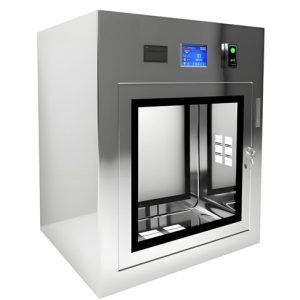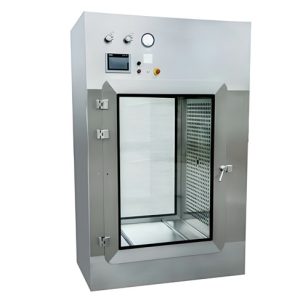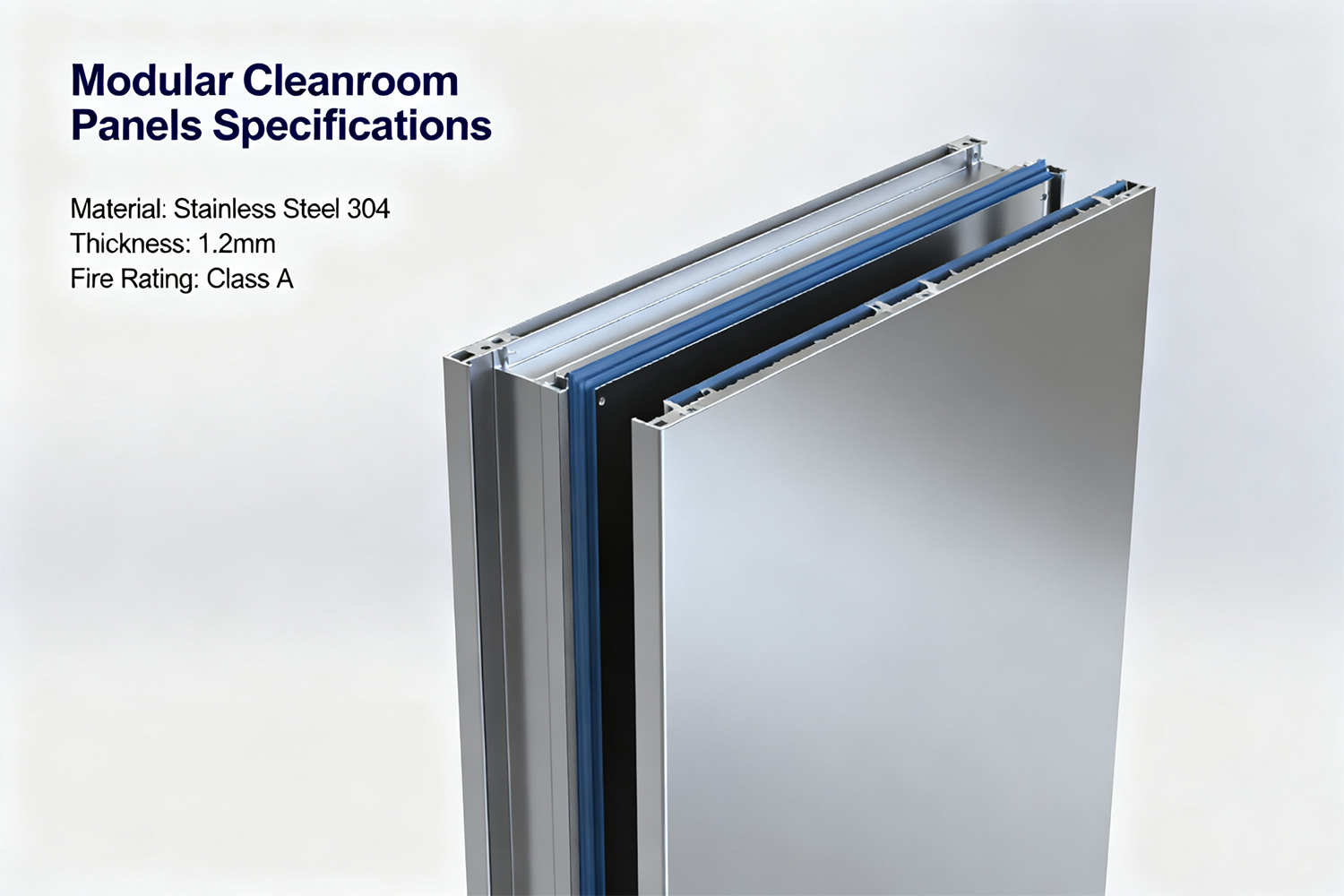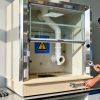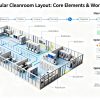Account
-
Safe payment options
We only work with the most secure payment systems.
-
Product return within 30 days
We do our very best to keep our customers happy.
No products in the cart.
You dont have any products in your cart yet, add a few products to experience this experience.
Add $500.00 to cart and get free shipping!
To see and take advantage of all discounted products.
Click HereModular Cleanroom Panels Specifications — Materials, Thickness, Fire Rating & Installation Guide
Modular cleanroom panels specifications determine cleanroom performance, fire safety, and long-term maintenance needs. This guide lists material choices, thickness ranges, thermal and fire ratings, sealing methods and installation notes — plus downloadable CAD and an RFP-ready spec template from Deiiang™.
Table of Contents
ToggleIntroduction
Proper modular cleanroom panels specifications are critical for facilities in pharmaceutical manufacturing, electronics assembly, biotechnology research, and medical device production. This comprehensive guide provides detailed technical specifications, performance metrics, and installation guidelines to help engineers, facility managers, and cleanroom designers select the optimal panel systems for their applications.
With over 15 years of experience in Modular Cleanroom Design, Deiiang™ engineers have compiled this resource to address the most common questions and technical requirements for cleanroom wall panel specifications. The content includes downloadable specification tables, CAD details, and calculation tools to streamline your cleanroom planning process.
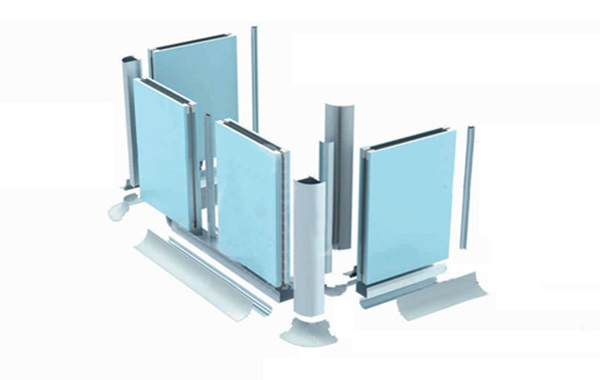
modular cleanroom panels
Why Panel Specifications Matter
Selecting appropriate panel material for modular cleanroom applications directly impacts operational performance and compliance. Inadequate specifications can lead to:
- Compromised cleanliness classification (failing ISO 14644 requirements)
- Reduced energy efficiency due to poor thermal performance
- Structural integrity issues under positive pressure conditions
- Increased maintenance costs and downtime
- Non-compliance with fire safety regulations
For example, a pharmaceutical facility selecting non-compliant fire rating cleanroom panels faced regulatory shutdown after failing to meet ASTM E84 Class A requirements, resulting in 3 weeks of production delays and $250,000 in lost revenue.
Common Panel Types & Typical Use Cases
Aluminum Honeycomb Panels
These modular cleanroom panels feature aluminum face sheets bonded to an aluminum honeycomb core, offering exceptional strength-to-weight ratios. Deiiang™ engineers typically recommend these for ISO Class 5-8 cleanrooms where structural integrity and lightweight properties are prioritized.
- Core density: 30-40 kg/m³
- Compressive strength: 0.8-1.2 MPa
- Thermal conductivity: 0.05-0.07 W/m·K
- Typical weight: 8-12 kg/m²
- Cleanability: Excellent with PVDF coating
Example application: Electronics assembly cleanroom requiring ESD protection, with panel thickness of 50mm achieving U-value of 0.45 W/m²·K.
PU/PIR Insulated Sandwich Panels
Polyurethane (PU) or polyisocyanurate (PIR) core panels provide superior thermal insulation, making them ideal for energy-conscious facilities. These insulated cleanroom panels are commonly used in pharmaceutical and biotechnology applications.
- Core density: 40-50 kg/m³
- Compressive strength: 0.15-0.25 MPa
- Thermal conductivity: 0.022-0.028 W/m·K
- Typical weight: 15-25 kg/m²
- Cleanability: Good with epoxy coating
Example calculation: A 60mm thick PU panel with conductivity 0.025 W/m·K provides U-value = 1/(0.06/0.025 + 0.04 + 0.13) = 0.37 W/m²·K.
Mineral Wool / Rockwool Panels
These panels offer exceptional fire resistance and acoustic performance, suitable for facilities with stringent fire safety requirements.
- Core density: 80-150 kg/m³
- Compressive strength: 0.04-0.08 MPa
- Thermal conductivity: 0.035-0.045 W/m·K
- Typical weight: 25-40 kg/m²
- Cleanability: Moderate with appropriate coating
Stainless Steel-Faced Panels
With excellent corrosion resistance and cleanability, these panels are the standard for pharmaceutical sterile areas and food processing cleanrooms.
- Face sheet thickness: 0.5-1.2 mm
- Surface roughness (Ra): 0.4-0.8 μm
- Thermal conductivity: Varies with core material
- Typical weight: 20-35 kg/m²
- Cleanability: Excellent, withstands aggressive disinfectants
Key Specification Parameters
Material & Face Sheets
Face sheet selection impacts durability, cleanability, and corrosion resistance. Deiiang™ offers:
- Galvanized steel (0.5-0.8mm) with PVDF coating for standard applications
- Stainless steel 304/316 (0.5-1.0mm) for corrosive environments
- Aluminum (0.8-1.2mm) with powder coating for lightweight requirements
Core Type & Properties
The core material determines thermal performance, fire resistance, and structural characteristics:
- PU/PIR core: Density 40-50 kg/m³, fire class B1/B-s1,d0
- Mineral wool: Density 100-150 kg/m³, fire class A2-s1,d0
- Aluminum honeycomb: Cell size 6-12mm, fire class A2-s1,d0
Panel Thickness Options and Recommended Uses
| Thickness (mm) | Application | ISO Class Typical | U-value Range (W/m²·K) |
|---|---|---|---|
| 25-40 | Office areas, changing rooms | ISO 8-9 | 0.65-0.85 |
| 40-60 | Electronics assembly, R&D | ISO 6-7 | 0.40-0.60 |
| 60-80 | Pharmaceutical manufacturing | ISO 5-7 | 0.25-0.40 |
| 80-100 | Bio-containment, critical processes | ISO 4-5 | 0.18-0.28 |
Modular Cleanroom Panels Weight and Handling Limits
Panel weight affects structural requirements and installation logistics:
- Aluminum honeycomb: 8-12 kg/m² (easy manual handling)
- PU insulated: 15-25 kg/m² (mechanical assistance recommended)
- Mineral wool: 25-40 kg/m² (requires mechanical handling)
Example: For a 3m × 2.4m mineral wool panel (30 kg/m²), total weight = 3 × 2.4 × 30 = 216 kg, requiring mechanical lifting equipment.
Thermal Performance Calculation
U-value calculation formula: U = 1 / (Rsi + Rpanel + Rse)
Where Rpanel = thickness (m) / thermal conductivity (W/m·K)
Standard resistances: Rsi = 0.13 m²·K/W (internal), Rse = 0.04 m²·K/W (external)
Example: 60mm PU panel (λ=0.025 W/m·K): Rpanel = 0.06/0.025 = 2.4 m²·K/W
U = 1 / (0.13 + 2.4 + 0.04) = 0.389 W/m²·K
Fire Rating Standards
Fire rating cleanroom panels must comply with regional standards:
- ASTM E84 (North America): Class A (0-25 flame spread), Class B (26-75), Class C (76-200)
- EN 13501 (Europe): A2-s1,d0 (non-combustible), B-s1,d0 (very limited contribution)
- Local codes: NFPA, IBC, GB standards (China)
Deiiang™ panels typically achieve ASTM E84 Class A and EN 13501 A2-s1,d0 ratings.
Air Tightness Performance
Critical for maintaining pressure differentials and cleanliness classification:
- Standard performance: ≤1.5 L/s·m² at 50 Pa pressure difference
- High performance: ≤0.5 L/s·m² at 50 Pa pressure difference
- Pharmaceutical grade: ≤0.3 L/s·m² at 50 Pa pressure difference
Surface Finish & Cleanability
Surface properties impact contamination control and maintenance:
- Surface roughness (Ra): 0.4-0.8 μm for optimal cleanability
- Chemical resistance: Withstand isopropyl alcohol, hydrogen peroxide, quaternary ammonium compounds
- Coved corners: Minimum 25mm radius for pharmaceutical applications
Modular cleanroom panels Standard Spec Table
| Parameter | Typical Value Range | Unit | Recommendation / Notes |
|---|---|---|---|
| Panel Type | Honeycomb, PU, Mineral Wool, SS | – | Select based on application requirements |
| Thickness | 25-100 | mm | 40-60mm for most ISO 5-7 applications |
| Weight | 8-40 | kg/m² | Consider structural capacity |
| U-value | 0.18-0.85 | W/m²·K | Lower for energy efficiency |
| Fire Rating | A2-s1,d0 / Class A | – | Verify local code compliance |
| Surface Finish | PVDF, Epoxy, SS | – | PVDF for durability, SS for cleanability |
| Max Joint Gap | 2-5 | mm | Tighter for higher cleanliness |
| Maintenance Interval | 6-24 | months | Depends on environment and usage |
Download Complete Excel Spec Sheet
Get our comprehensive specification template with all parameters, calculations, and supplier checklist.
Joint Design & Installation Details
Proper cleanroom panel installation details are critical for performance:
Tongue-and-Groove Joints
Most common system with integrated gasket channels
- Air leakage: ≤0.5 L/s·m² at 50 Pa
- Installation tolerance: ±1.5 mm
- Recommended for: ISO 5-8 cleanrooms
Male/Female Joints
Positive interlocking system with thermal break
- Air leakage: ≤0.3 L/s·m² at 50 Pa
- Installation tolerance: ±1.0 mm
- Recommended for: ISO 3-5 cleanrooms
Clip Systems
Concealed fastening for seamless appearance
- Air leakage: ≤0.4 L/s·m² at 50 Pa
- Installation tolerance: ±1.0 mm
- Recommended for: All classifications
Sealant & Gasket Specifications
- Material: Silicone, EPDM, or closed-cell neoprene
- Temperature range: -40°C to +120°C
- Compression set: ≤10% after 1000 hours at 70°C
- Chemical resistance: Withstand common cleanroom disinfectants
Tolerances & Flatness Requirements
Proper installation ensures optimal performance:
- Panel flatness: ≤2 mm over 2m length
- Joint alignment: ≤1.5 mm deviation
- Vertical alignment: ≤3 mm over 3m height
- Anchoring spacing: 600-1200 mm depending on panel weight
Cleanability, Surface Treatments & Maintenance
Chemical Resistance Guide
| Disinfectant | PVDF Coating | Epoxy Coating | Stainless Steel |
|---|---|---|---|
| Isopropyl Alcohol (70%) | Excellent | Excellent | Excellent |
| Hydrogen Peroxide (3%) | Good | Good | Excellent |
| Quaternary Ammonium | Excellent | Good | Excellent |
| Sodium Hypochlorite (1%) | Fair | Poor | Good |
Recommended Cleaning Procedures
Proper maintenance extends panel life and maintains cleanliness:
- Frequency: Weekly for ISO 5-6, monthly for ISO 7-8
- Method: Wipe with lint-free cloth and approved disinfectant
- Pressure: 0.5-1.0 bar for spray applications
- Rinse: Deionized water for critical applications
Deiiang™ recommends validation of cleaning procedures every 6 months for pharmaceutical applications.
Testing, Certification & Quality Assurance
Comprehensive testing ensures panel performance and regulatory compliance:
Required Tests and Standards
- Fire performance: ASTM E84, EN 13501-1
- Structural integrity: Panel shear test (≥15 kN/m), compressive test (≥0.15 MPa)
- Air leakage: EN 12114 or equivalent at 50-150 Pa
- Surface roughness: ISO 4287 (Ra 0.4-0.8 μm)
- Microbial growth: ASTM G21 for pharmaceutical applications
Documentation Requirements
Request these documents from your modular cleanroom panels supplier:
- Material certificates (mill certificates for metals)
- Third-party test reports for fire performance
- Quality control records from production
- Installation and maintenance manuals
- Warranty documentation
FAQ
What thickness for ISO 7 cleanroom?
For ISO Class 7 cleanrooms, Deiiang™ typically recommends 50-60mm thick panels with U-values between 0.35-0.50 W/m²·K. This provides adequate insulation and structural integrity while maintaining cost-effectiveness.
Are honeycomb panels fire rated?
Yes, properly constructed aluminum honeycomb panels can achieve fire ratings up to A2-s1,d0 according to EN 13501-1 and Class A according to ASTM E84. The fire performance depends on the specific core material and facing sheets used.
How to clean panel seams?
Clean panel seams using lint-free wipes with approved disinfectants. For stubborn contamination, use soft plastic scrapers followed by disinfectant application. Avoid abrasive tools that could damage sealants. Deiiang™ recommends quarterly inspection of seams for integrity.
What is the typical lifespan of cleanroom panels?
With proper maintenance, Deiiang™ modular cleanroom panels typically last 15-25 years. PVDF-coated steel panels show minimal degradation after 20 years in controlled environments, while stainless steel panels can exceed 25 years with appropriate care.
Can existing panels be modified for new requirements?
Yes, within limits. Deiiang™ offers panel modification services including cutouts for new utilities, surface recoating, and joint reinforcement. However, structural modifications should always be evaluated by qualified engineers.
Resources & Downloads
Access these valuable resources for your Modular Cleanroom Design project:
- DWG/CAD Details – Standard panel details and joint configurations
- Excel Spec Template – Customizable specification spreadsheet
- Testing Standards Reference – Complete list of relevant ISO, ASTM, and EN standards
- Deiiang™ Panel Spec Whitepaper – Technical deep dive (12 pages)
Conclusions & Next Steps
Proper modular cleanroom panels specifications are fundamental to achieving and maintaining your required cleanliness classification, energy efficiency, and operational safety. This guide has provided comprehensive technical information on materials, performance characteristics, and installation considerations.
For your specific application, Deiiang™ recommends:
- Download our complete specification sheet for your RFP process
- Request quotations from at least three qualified suppliers
- Schedule a technical review with Deiiang™ engineers to validate your specifications




